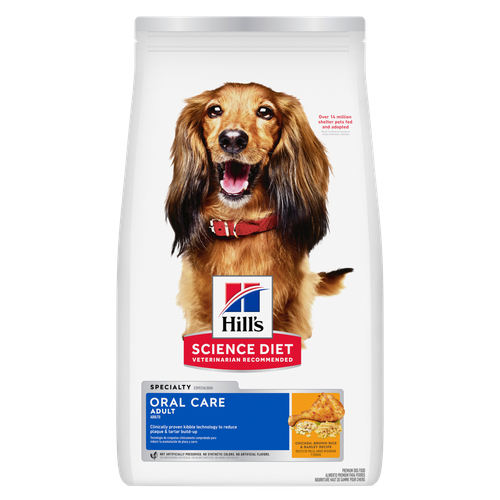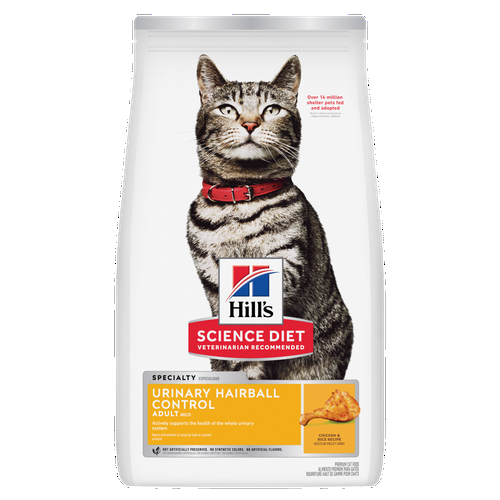
-
Find the right food for your petTake this quiz to see which food may be the best for your furry friend.Find the right food for your petTake this quiz to see which food may be the best for your furry friend.Featured products
 Adult Small & Mini Lamb Meal & Brown Rice Recipe Dog Food
Adult Small & Mini Lamb Meal & Brown Rice Recipe Dog FoodFor the faster metabolism of Small & Mini dogs
Shop Now Adult 7+ Small & Mini Chicken & Brown Rice Recipe Dog Food
Adult 7+ Small & Mini Chicken & Brown Rice Recipe Dog FoodFor the unique nutritional needs of mature Small & Mini dogs
Shop Now Hill's Science Diet Adult Oral Care Chicken, Brown Rice & Barley Recipe Dog Food
Hill's Science Diet Adult Oral Care Chicken, Brown Rice & Barley Recipe Dog FoodClinically proven kibble technology to reduce plaque & tartar build-up
Shop NowFeatured products Adult Urinary Hairball Control Chicken & Rice Recipe Cat Food
Adult Urinary Hairball Control Chicken & Rice Recipe Cat FoodActively supports the health of the whole urinary system
Shop Now Adult Indoor Chicken Recipe Cat Food
Adult Indoor Chicken Recipe Cat FoodSupports energy level and beautiful fur in indoor cats
Shop Now Hill's Science Diet Adult Sensitive Stomach & Skin Dog Food
Hill's Science Diet Adult Sensitive Stomach & Skin Dog FoodHighly digestible recipe, gentle on stomachs. Nourishes skin & promotes a lustrous coat
Shop Now -
Featured articles
 My Pet Ate a Lizard — What Should I Do?
My Pet Ate a Lizard — What Should I Do?Learn what to do if your pet eats a lizard, including whether they can be toxic and symptoms to keep an eye on when they've swallowed one.
Read More 15 Pet-Friendly Cities Ideal for a US Road Trip
15 Pet-Friendly Cities Ideal for a US Road TripCheck out our list of pet-friendly U.S. cities that are excellent travel options, offering off-leash dog parks and pet-friendly restaurants & hotels.
Read More Easy DIY Dog & Cat Toys: Nine of Our Favorites
Easy DIY Dog & Cat Toys: Nine of Our FavoritesBrowse this comprehensive guide for several of our favorite DIY dog and cat toys that are sure to put a little pep in your pet's step.
Read More -


You may have heard that the best dog food for one dog may not be the best for another–and for good reason. Age, current weight, and unique needs should all be considered carefully when deciding which product to buy, never mind whether you should buy wet or dry food. Fortunately, these simple pointers will lead you to a healthy dog food that fits perfectly with your canine's lifestyle.
Nutrients to Look For
When matching up a food for your dog, you need to recognize the crucial nutrients all dogs need. Depending on your dog's age, lifestyle and health issues (if any), you may need to increase certain nutrients to help him stay healthy. Your veterinarian will advise you on what to look for if your pooch has special health considerations.
In general, the six types of nutrients every dog food should contain are proteins, carbohydrates, fats, fiber, vitamins and minerals. A dog food that includes quality ingredients and balances the nutrients within those ingredients will put your dog in a position to properly absorb them.
Here is a list of the six nutrients and the ingredients you may see on a dog food label that contain them:
- Protein helps to reinforce your dog's muscles, bones, and skin so they can support the rest of the body. It can be found in ingredients like chicken, salmon, soybean meal, barley, corn or eggs.
- Carbohydrates provide your dog energy throughout the day. Carbs can be found in barley, corn, rice, and sorghum.
- Fats are also needed for energy and healthy skin. They can be found in fish and vegetable oils.
- Fiber is crucial to keep your dog's digestive system operating properly, which is a benefit you both share. Fiber can be found in beet pulp, soybean mill run and cellulose.
- Vitamins your dog needs are included in many of the above ingredients listed above, as well. Eggs are a good source of Vitamins A and E, whereas brown rice is full of potassium; and liver and beef contain iron. When your dog gets the vitamins he needs, his heart, liver, and immune system will work efficiently, helping him to lead a healthier life.
- Minerals are also essential for well-balanced nutrition, and similar to vitamins, may be found in the above ingredients. Minerals like magnesium help support strong bones and teeth, while the right amount of sodium promotes a healthy heart.
Consider His Age
Keep in mind that as your dog goes through different life stages, he'll need certain vitamins and nutrients to help him stay healthy. For example, puppies benefit greatly from B12 in their nutrition, which helps growth and development. Calcium, phosphorus, and vitamin D are also crucial to healthy bones and teeth, so as your puppy goes through his teething phase it is important to make sure his food includes appropriate levels of all three of these vitamins.
Conditional Carbs
Once you're aware of these types of crucial nutrients, it's time to determine which ones your dog may need more of to maintain a healthy lifestyle. This is where your vet can guide you: Does your dog have skin or oral health issues? What about joint problems or signs of being overweight? Talk with your vet for a more comprehensive list of nutrients and ask for recommendations so you can provide him with the proper food.
Cost and Source
Next, think about where you want to buy your dog food–at your veterinarian's office, in a pet store or online. Many quality dog foods offer these three routes of purchase. Start by checking out a few product lines on the manufacturer's website. Not only will the best dog food manufacturers list where they're sold, but many will detail all the ingredients and the nutritional benefits of the food. Some dog food manufacturers and retailer websites offer a filter-and-search option that allows you to find a dog food that fits your dog's age, health needs, and activity level. If you find a food that looks like a perfect fit, see if the pet food manufacturer–or the retailer or veterinarian you plan to buy from–offers any promotional material on that food. Don't let the cost of dog food scare you; a healthy canine comes out of eating a healthy dog food, not just the most expensive one. Many pet food companies offer coupons when you follow them on social media, or on their websites.
Continue to monitor your dog's health and activity level, as your dog's nutritional needs can change over time. If he's showing signs that he needs a change in food, consult with your veterinarian if you are unsure what to choose. The best dog food companies offer a variety of food options that can allow you to transition your dog to a new food without completely disrupting his digestive system.


Tasty Tips
The 95 Percent Rule
Just as important as the ingredients that provide your dog his nutrients are the ingredients you should avoid. The Association of American Feed Control Officials (AAFCO) sets guidelines all US dog food companies must follow, but some pet food manufacturers can still be misleading when they disclose how much of each ingredient their food contains.
Consumers should specifically look at the product's Nutritional Adequacy Statement, which "indicates the food is complete and balanced for a particular life stage, such as growth, reproduction, adult maintenance or a combination of these, or intended for intermittent or supplemental feeding only. Products conspicuously identified on the principal display panel as a snack, treat, or supplement are exempt."
Products labeled as meat (eg "beef"), according to the AAFCO, must include 95 percent of that meat (not including water) in order to name it as such. From here, be on the lookout for artificial flavors and colors that don't add any nutritional content to the food.
Wet vs. Dry
When looking for a dog food that has the nutrients your pet needs, both wet and dry products can be a good fit. But is one better than the other? Most of the time choosing which to feed your dog is a matter of personal preference. Some pet parents prefer dry food because you can leave it in the dish for longer without spoiling and it's easier to cleanup. Others find that dogs prefer wet food and eat better when it's served. If your dog doesn't drink much water, , or struggles to eat/chew as he ages, wet food may be a better way to keep him healthy. Both dry and wet dog food can deliver the nutrients your dog needs, though, so unless he has a specific health concern, pick the one to which you feel he responds best.
Putting It All Together
Choosing the best dog food means finding a brand that uses quality ingredients in a way that properly balances the protein, carbohydrates, fat, fiber, and vitamins your dog needs based on his age, lifestyle, and unique state of health. Look for a healthy dog food that has met or exceeded these guidelines and follows the individual needs of your pet as determined by your vet. Spending a little extra time choosing a perfect dog food could mean that much more enjoyment with a healthy and happy four-legged best friend.


Chrissie Klinger is an educator, writer and mother of two children, three dogs and three cats. Her dog Jake loves sitting on her lap every chance he gets! She enjoys living an active and eco-friendly lifestyle in rural Pennsylvania.
Related products

Improves everyday ability to get up & go

For the unique nutritional needs of mature Small & Mini dogs

Clinically proven kibble technology to reduce plaque & tartar build-up

For the faster metabolism of Small & Mini dogs
Related articles

Understand the role that Omega-6 and Omega-3 fatty acids play in your dog's overall health, and how you can ensure they are getting enough.

Discover how the field of dog science is giving us more and more insights into the inner workings of our furry best friends.

Your dog's coat and skin are a big part of your dog's overall health. Ensure you keep your dog's coat healthy, by following these simple tips.

Learn basic steps & precautions for treating a cut on your dog, including what you can put on the cut, and when you should take them to the vet.

Put your dog on a diet without them knowing
Our low calorie formula helps you control your dog's weight. It's packed with high-quality protein for building lean muscles, and made with purposeful ingredients for a flavorful, nutritious meal. Clinically proven antioxidants, Vitamin C+E, help promote a healthy immune system.
Put your dog on a diet without them knowing
Our low calorie formula helps you control your dog's weight. It's packed with high-quality protein for building lean muscles, and made with purposeful ingredients for a flavorful, nutritious meal. Clinically proven antioxidants, Vitamin C+E, help promote a healthy immune system.

